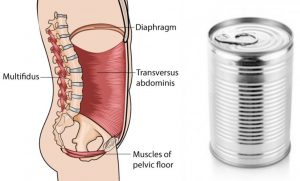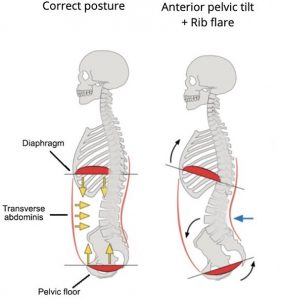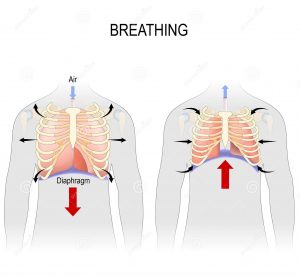Well, it could be a result of the way you breathe. Pregnancy and child birth definitely put stress on the pelvic floor (a hammock of muscle from your pubic bone to the tailbone) and causes pelvic floor weakness. But did you know that the health of your pelvic floor is directly related to the mechanics of your breath? The shallower you breathe, the less effective your pelvic floor will function. And when your pelvic floor isn’t functioning properly you can have all sorts of uncomfortable and embarrassing symptoms.
Unfortunately seeking help for pelvic floor issues isn’t quite like seeing a physio for back or leg pain. When it comes to talking about symptoms like a bulging vagina or leaking bladder or painful intercourse, it can be quite embarrassing and sometimes overwhelming. A lot of mums tend to suffer in silence and become anxious and depressed as their symptoms worsen.
But Mummylicious thinks that having the freedom to NOT worry about your pelvic floor is a gift that all Mums should enjoy!! So today I am going to share a little knowledge and expertise to help keep you healthy and happy inside and out.
So let’s learn about your core and some easy adjustments you can make right now to help prevent problems starting or worsening. As I mentioned, breathing and pelvic floor integrity have a special relationship. Proper rib movement helps set up a great foundation for diaphragm function which affects how our abdominals and pelvic floor will function.
 Think of your core like a canister of muscles working together to support the spine. Your Diaphragm is the lid on top, your abdominals (TA – Transverse abdominals) wrap around the sides and your pelvic floor is the base. When you have the right alignment of your diaphragm & pelvic floor along with core tension around the middle, your pelvic floor can lift properly and be able to keep your organs from pushing down and out of your vagina.
Think of your core like a canister of muscles working together to support the spine. Your Diaphragm is the lid on top, your abdominals (TA – Transverse abdominals) wrap around the sides and your pelvic floor is the base. When you have the right alignment of your diaphragm & pelvic floor along with core tension around the middle, your pelvic floor can lift properly and be able to keep your organs from pushing down and out of your vagina.
Your canister also regulates pressure when breathing to support your spine. When one of the structures of this canister is not functioning correctly, the rest of the unit will be compromised. Take for instance rib flare and breathing mechanics. Here’s what happens when we breath:
On Inhale your diaphragm and pelvic floor go down and your chest, back and sides expand out.
On Exhale your diaphragm goes up, ribs (chest back and sides) come in and pelvic floor goes up.
Sometimes in pregnancy the ribs move and flare to make room for the baby. This starts to pull on the diaphragm in one direction, affecting its ability to function (strength decreases as the muscle is stretched). With the front ribs opened, the back ribs can get squeezed and stuck preventing full 360 degree rib opening as you breath in and out.
 To compensate the body does a more shallow upper breathing pattern lifting shoulders and even arching back to allow air into the lungs. This weakens the diaphragm and intercostals (muscles between the ribs) that are necessary for good 360 breathing mechanics.
To compensate the body does a more shallow upper breathing pattern lifting shoulders and even arching back to allow air into the lungs. This weakens the diaphragm and intercostals (muscles between the ribs) that are necessary for good 360 breathing mechanics.
And if the ribcage can’t expand and compress in a balanced way it can lead to poor containment of pressure sending extra force down into your lower abs and pelvic floor. This extra pressure can cause symptoms of bladder leakage or protrusion form the pelvic floor.
So if this is happening to you, you might need to try a simple 360 breathing technique. Sit tall (align your canister) and wrap your hands around the sides of your rib cage – fingers in the front and thumbs on your back ribs. Focus first on slow, full inhales and then slow, full exhales with a “hhaaaa” sound as you exhale.
Try to breathe in through your nose expanding the rib cage in all directions feeling your fingers expand and thumbs move out as well. Be sure to keep your shoulders down and think of the air going down into your lengthened torso. Feel your pelvic floor gently opening and widening.
Now, exhale through your mouth with “hhaaa” as you gently draw your rib cage in on all sides and slowly lift your pelvic floor. Imagine you are sipping a milk shake through a thick straw up into your vagina.
Repeat the process slowly with your eyes closed feeling the rib movements in and out. Use the inhale to stretch the restricted areas in the back ribs and the exhale to compress the front areas that are too mobile.
This exercise will promote good rib movement without overusing your abs. This is important not only to avoid putting too much stress on your abs as they are healing, but also to help make sure you’re not putting too much pressure down onto your pelvic floor.
Gentle breathing drills can be performed early on in your recovery or anytime throughout motherhood, but make sure it isn’t causing any pain or discomfort or aggravating a c-section incision site. When starting out ensure a relaxed exhale instead of a forceful one as you work on rewiring and balancing out the system. It should just be your intercostals working and a natural lift and rebound of your pelvic floor and diaphragm.
If you would like help with this exercise and to learn other techniques to improve your pelvic floor, be sure to join our Pilates or Group Fitness sessions guided by MumSafe ™ Postnatal Fitness Specialists. We work with you to ensure you are taken care of from the inside out.




